How to arrange air heating of a country house: rules and schemes of construction
Traditionally, water is used as a heat carrier in heating systems. This familiar heating method has both advantages and disadvantages. When building your own home, the possibilities for experimentation with the owner are almost unlimited.
It makes sense to consider alternatives. The most interesting of them is air heating of a country house. We will dwell on it in more detail in this article.
The content of the article:
How to warm the house with air?
Air is a very efficient heat carrier, much more convenient than water. The easiest option for such heating is ordinary fan heater. This device, consisting of a fan and a heating coil, can warm up a small room in literally minutes. Of course, for a private home you will need more serious equipment.
As a heat source, you can use gas or solid fuel boiler. An electric heater is also suitable, but this option is considered not too profitable, since the cost of electricity increases significantly.
An interesting and environmentally friendly option for heating is the use of solar panels or solar collector. Such systems are placed on the roof. They either immediately transfer the thermal energy of the sun to the heat exchanger, or convert it into inexpensive electrical energy. In the latter case, the fan can also be powered from the battery.
Air is heated in a heat exchanger and enters separate rooms through air ducts. These are rather bulky designs made of durable metal. The cross section of the ducts is much larger than the diameter of the water heating pipe.
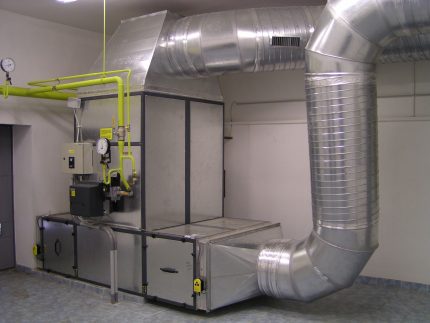
But radiators for air heating are not needed. Warm air simply fills the rooms through special grilles. As you know, hot gas tends to rise. Cold air will be forced down.
From here, cold air flows back to the heat exchanger, heat up, enter rooms, etc.

Almost all air heating systems provide for the installation of a fan that pumps hot air and makes it move through the heating system. The presence of such a device makes the system dependent on electrical energy.
You can make a system in which hot air will move naturally, without any fan. However, the efficiency of such systems usually leaves much to be desired, since the rooms in this case warm up too slowly.
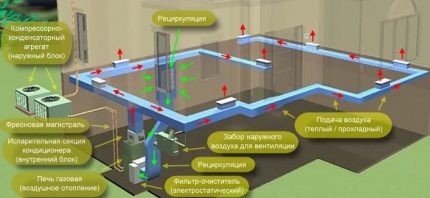
Features of air heating
Compared to traditional water heating, air systems have many advantages. For example, there is a high efficiency of such a system, which can be 90%. The efficiency of water heating rarely reaches 65%.
If the air heating is arranged correctly, the air warms up the rooms extremely quickly, literally in a matter of minutes. The temperature in the rooms is regulated using automatic equipment that turns the heater on and off as needed.
As a result, the house is always warm, and heating costs are reduced. Using an air heating system is easier. Ducts do not clog as often as water heating pipes, respectively, they are less likely to need to be cleaned.
For obvious reasons, owners of air heating systems do not have problems with leaks, as well as with the threat of pipe freezing, if the boiler stopped working for some reason in the cold season.
Having learned about the advantages of air heating, its disadvantages should be evaluated. To begin with, it is very difficult to install such a system in an already built house, and it is not always possible. You can’t just dismantle pipes and radiators for water heating and install air ducts and grilles instead, since completely different principles are used here.
Bulky air ducts will take up much more space, and they will not look too aesthetically pleasing along the walls. Usually they are placed behind suspended ceilings, false panels, etc. In fact, such a reorganization of heating will require a major overhaul of the entire house.

Before you start breaking walls, you will have to carry out serious engineering calculations. That is why it is recommended to arrange air heating in the house at the stage of its construction. And all the necessary calculations are carried out during the design of the building. In this case, you can get a convenient, reliable and highly efficient heating system.
Another problem is the dependence of the air heating of a private house on the availability of electricity. The fan does not spin, the hot air does not move, the rooms cool as fast as they did. You will have to spend money on some alternative source of electricity, for example, on a generator.
System Design Principles
When designing air heating systems, many important factors are considered. First of all, it is the heat demand of each separate room, as well as heat loss for each room. Doors, windows, ventilation openings and other objects make precious kilojoules of thermal energy go outside.
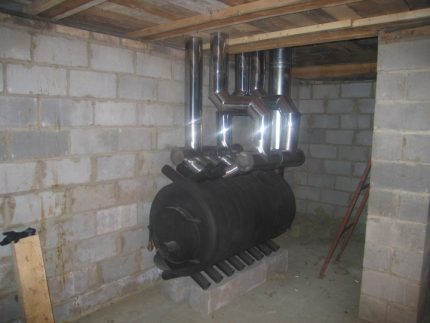
The most important point is the availability of high-quality insulation of the building. If the house has plastic windows, good doors, and its facade is reliably insulated, heat loss will be less, and heating costs can be significantly reduced.If we are talking about the reconstruction of the building, you should start with insulation design.
After the need for thermal energy and its costs are correlated, the power of the heating equipment is calculated and its type is selected. Then the parameters of the hot air flow are calculated. Perform special aerodynamic calculations to calculate the required dimensions of the ducts.
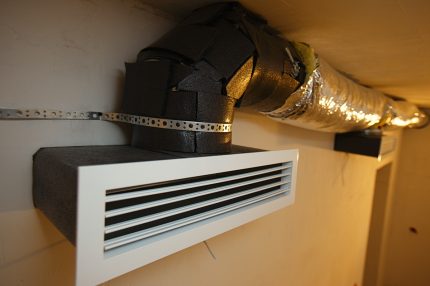
Pre-calculate the power of the equipment can be based on the following figures: for heating every 10 square meters. meters of space will need about 0.7-0.8 kW of heat. This is provided that the house is properly insulated, otherwise more powerful equipment will be needed. But the full design and detailed calculations are best left to an experienced engineer.
Incorrect calculations can affect the state of the finished system very sadly. Unprofessionally designed air heating systems are characterized by such problems as frequent equipment breakdowns, indoor air overheating, equipment overheating, drafts, and increased noise levels.
Simultaneously with the design of the air heating system, it makes sense to think about the placement of stationary pieces of furniture in the house. Supply and exhaust grilles should be located in places remote from the constant presence of people.
They also should not be hidden under cabinets, cabinets or other objects that impede the free movement of air masses.
In a multi-story private house, it is recommended to install exhaust grilles in such a way that on the upper floors the cooled air is drawn into the system from above, and on the lower floors from below. This will provide a more even distribution of heat throughout the premises. Read more about how to calculate air heating correctly in this stuff.
Varieties of air heating systems
Among the heating systems known to science, there are three varieties:
- direct-flow;
- recirculation (it is also gravitational);
- recirculation with partial intake of outdoor air.
Direct-flow systems are the oldest and simplest in design. They were used in ancient Rome and were widespread in London before the industrial and technological revolution.
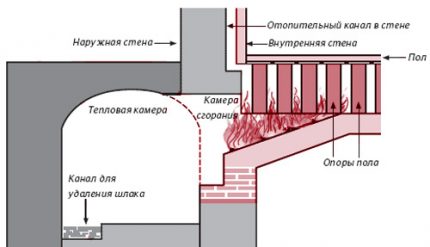
With a direct-flow system, a heating device, i.e. a wood stove or fireplace, was located in the lower part of the house, optimally in the basement. Heat from the air heated by the furnace rose up, transferred to the walls and ceilings.
To improve the circulation of hot air and the efficiency of heating, special holes were made in the floor.
The cooled air left the room through the openings in the roof, and the stove (fireplace) warmed up the new air masses that came from outside, since serious thermal insulation of buildings in those days was not yet developed.
The low efficiency of the once-through systems is obvious. It requires the combustion of a large amount of fuel, but a significant part of the heat is absorbed by the material of the walls, floors and floors.
At the same time, the rooms warm up unevenly: it is too hot below, and the upper rooms no longer have time to heat up. Part of the heat generally left the house through the roof, along with air.
A more modern recirculation system appeared due to the development of gas heating. Heating equipment of this type allows you to warm up not the whole house, but only specific air masses. From them, air flows are formed, which are sent from the bottom up to specific rooms.
Hot air masses in this case displace the cold air, which leaves through the grilles arranged in the floor of the room. Cold air flows through the air ducts to the heater and returns to the system as a hot stream. The recycle cycle is repeated over and over.
The cost of thermal energy with a recirculation heating system is several times less than when using a direct-flow circuit. But there are disadvantages in this option. A closed system prevents the renewal of air, which affects the quality of life in the house.
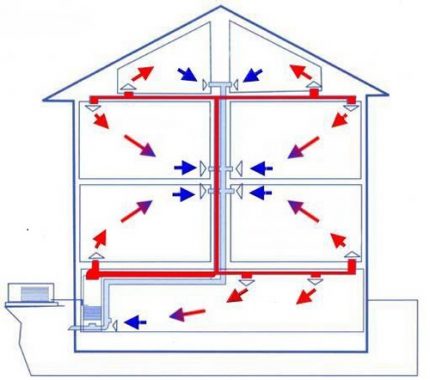
Part of the problem can be solved using tools such as filters, ionizers, humidifiers etc. But good devices of this type are quite expensive, and their maintenance will require additional effort, as well as automation.
More effectively, the problem of restoring airflows can be solved with the help of a recirculation heating system with partial intake of air from the outside.
When arranging such a scheme, a partial withdrawal of a small amount of air outside and the intake of an appropriate amount of air mass from the street are provided. As a result, the composition of the air inside the building is regularly updated.
Recirculation systems operate on a gravitational principle: hot flows rise up, and cold flows fall down. Unfortunately, not in every building, such circulation is quite effective. In this case, a fan is included in the system to force the recirculation process.
System installation features
If the calculations are performed at a high professional level, and the design of the air heating system of the cottage is made, you can perform the installation yourself.
To do this, you will need:
- heating device;
- air ducts;
- fan;
- gratings;
- fasteners;
- ductwork tool, etc.
As a heater, a gas generator is usually used as the most cost-effective option. Ducts can have a rectangular, square, round or oval cross-section.
Usually suitable designs can be ordered from the factory that manufactures ventilation systems.
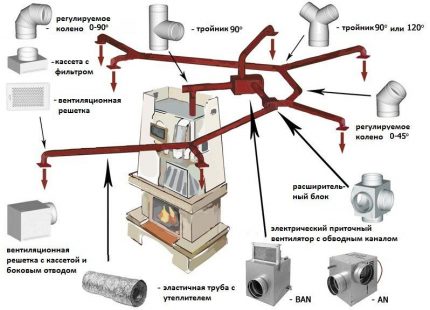
Typically, air ducts are made of galvanized steel, they are light enough to not overload the supporting structures of the house, and also have increased resistance to wear and corrosion. For rigid ducts, special elements are needed that provide a slope of 45 or 90 degrees. And for flexible products such elements are not needed.
Ducts are also made of ordinary steel, copper, plastic and other materials. There are even textile designs of this type.In places with high humidity it is recommended to use copper elements, as more stable for such conditions.
Plastic constructions are relatively inexpensive, they can be used away from potential sources of ignition.
Ducts are fixed under the ceiling and floor, as well as inside the walls. If there is a need to lay the duct not inside, but along the wall, it is closed with a false panel. Mounted in the ceiling and floor at the ends of the ducts ventilation grates.
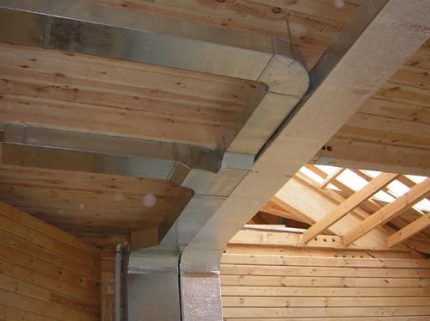
Air masses moving inside the structure can make a certain noise. To reduce this negative effect, it is recommended to hide the air ducts under a layer of sound insulation.
Usually this material also has thermal insulation properties, which only increases the efficiency of the system.
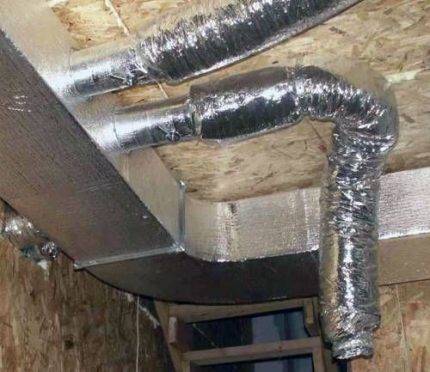
It is worth considering the option of acquiring ducts that already have such an insulating layer. This will simplify and speed up installation work.
If there is a need to install a fan, or several such devices, then it is usually included in the system next to the heater. Power is supplied to the fan and also provides a backup source of electricity.
The system also includes one or more filters. These can be mechanical filters that prevent the spread of dust particles. Along with these devices, it is recommended to install a carbon filter, which absorbs various odors. Of course, filters need periodic cleaning and / or replacement.
Part of the duct is led outside to provide fresh air. This segment is brought to the filter system, and then air is supplied to the heat exchanger of the heating device. If installation works are carried out at the stage of building a house, then their implementation usually does not cause great difficulties. The main thing is a good project.
To improve the microclimate in the house, useful elements such as an air humidifier, ionizer, ultra-violet sterilizer, etc. are built into the air heating system. These elements are not mandatory, but if the means allow, do not refuse them.
Another useful device is a channel air conditioner. It is also integrated into the duct system. This will allow you to use the system in the warm season to cool the air in the room.
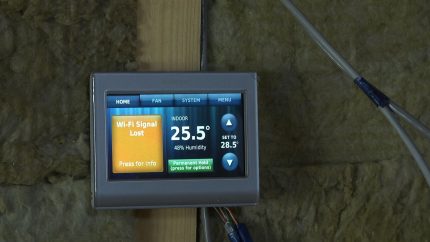
The final stage is the connection of an automatic control system. You will need air temperature sensors in the rooms and a control panel with a processor that will process the received data and regulate the operation of the heating equipment.
Conclusions and useful video on the topic
Interesting information on calculations and design of air heating is shown here:
In this video you can see two options for relatively inexpensive installation of air heating systems using devices and materials of Russian manufacture:
Air heating is a worthy and profitable option for heating a private house. It is more efficient than traditional water systems and can significantly improve the quality of life in the house. But in order to guarantee the successful implementation of this idea, the system must be correctly calculated and professionally designed.
Have a question? Or have personal experience using air heating for your home? Please share your own opinion on this issue.Leave comments, ask questions, share tips in the block below.

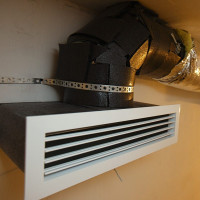 DIY air heating: all about air heating systems
DIY air heating: all about air heating systems 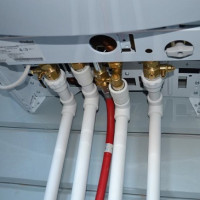 How the boiler is strapped with polypropylene: the rules for the construction of the pp circuit
How the boiler is strapped with polypropylene: the rules for the construction of the pp circuit 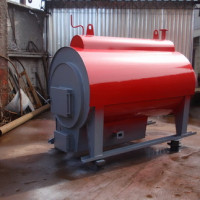 How to make steam heating yourself: device, rules and requirements
How to make steam heating yourself: device, rules and requirements 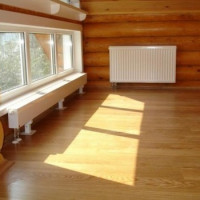 Heating in a wooden house: a comparative overview of suitable systems for a wooden house
Heating in a wooden house: a comparative overview of suitable systems for a wooden house 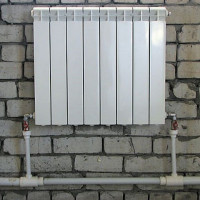 One-pipe heating system of a private house: schemes + an overview of the advantages and disadvantages
One-pipe heating system of a private house: schemes + an overview of the advantages and disadvantages 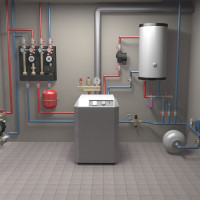 Water heating in a private house: rules, norms and organization options
Water heating in a private house: rules, norms and organization options  How much does it cost to connect gas to a private house: the price of organizing gas supply
How much does it cost to connect gas to a private house: the price of organizing gas supply  The best washing machines with dryer: model rating and customer tips
The best washing machines with dryer: model rating and customer tips  What is the color temperature of light and the nuances of choosing the temperature of the lamps to suit your needs
What is the color temperature of light and the nuances of choosing the temperature of the lamps to suit your needs  Replacement of a geyser in an apartment: replacement paperwork + basic norms and requirements
Replacement of a geyser in an apartment: replacement paperwork + basic norms and requirements